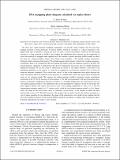| dc.contributor.author | Roland, C. Brian | |
| dc.contributor.author | Hatch, Kristi Adamson | |
| dc.contributor.author | Prentiss, Mara | |
| dc.contributor.author | Shakhnovich, Eugene Isaacovitch | |
| dc.date.accessioned | 2012-02-09T18:42:28Z | |
| dc.date.issued | 2009 | |
| dc.identifier.citation | Roland, C. Brian, Kristi Adamson Hatch, Mara Prentiss, and Eugene I. Shakhnovich. 2009. DNA unzipping phase diagram calculated via replica theory. Physical Review E 79(5): 051923. | en_US |
| dc.identifier.issn | 1539-3755 | en_US |
| dc.identifier.uri | http://nrs.harvard.edu/urn-3:HUL.InstRepos:8148861 | |
| dc.description.abstract | We show how single-molecule unzipping experiments can provide strong evidence that the zero-force melting transition of long molecules of natural dsDNA should be classified as a phase transition of the higher-order type (continuous). Toward this end, we study a statistical-mechanics model for the fluctuating structure of a long molecule of dsDNA, and compute the equilibrium phase diagram for the experiment in
which the molecule is unzipped under applied force. We consider a perfect-matching dsDNA model, in which the loops are volume-excluding chains with arbitrary loop exponent c. We include stacking interactions,
hydrogen bonds, and main-chain entropy. We include sequence heterogeneity at the level of random sequences; in particular, there is no correlation in the base-pairing (bp) energy from one sequence position to the next. We present heuristic arguments to demonstrate that the low-temperature macrostate does not exhibit degenerate
ergodicity breaking. We use this claim to understand the results of our replica-theoretic calculation of the equilibrium properties of the system. As a function of temperature, we obtain the minimal force at which the molecule separates completely. This critical-force curve is a line in the temperature-force phase diagram that marks the regions where the molecule exists primarily as a double helix versus the region where the molecule exists as two separate strands. We compare our random-sequence model to magnetic tweezer experiments performed on the 48 502 bp genome of bacteriophage λ. We find good agreement with the experimental data, which is restricted to temperatures between 24 and 50 °C. At higher temperatures, the critical-force curve of our random-sequence model is very different for that of the homogeneous-sequence version of our model. For both sequence models, the critical force falls to zero at the melting temperature T\(_c\) like \(|T−T_c|\)\(^α\). For the
homogeneous-sequence model, \(\alpha\)=1/2 almost exactly, while for the random-sequence model, \(\alpha\)\(\approx\)0.9. Importantly, the shape of the critical-force curve is connected, via our theory, to the manner in which the helix
fraction falls to zero at T\(_c\). The helix fraction is the property that is used to classify the melting transition as a type of phase transition. In our calculation, the shape of the critical-force curve holds strong evidence that the zero-force melting transition of long natural dsDNA should be classified as a higher-order (continuous) phase
transition. Specifically, the order is 3rd or greater. | en_US |
| dc.description.sponsorship | Physics | en_US |
| dc.language.iso | en_US | en_US |
| dc.publisher | American Physical Society | en_US |
| dc.relation.isversionof | doi:10.1103/PhysRevE.79.051923 | en_US |
| dc.relation.hasversion | http://arxiv.org/ftp/cond-mat/papers/0703/0703588.pdf | en_US |
| dash.license | LAA | |
| dc.title | DNA Unzipping Phase Diagram Calculated Via Replica Theory | en_US |
| dc.type | Journal Article | en_US |
| dc.description.version | Version of Record | en_US |
| dc.relation.journal | Physical Review E | en_US |
| dash.depositing.author | Prentiss, Mara | |
| dc.date.available | 2012-02-09T18:42:28Z | |
| dc.identifier.doi | 10.1103/PhysRevE.79.051923 | * |
| dash.contributor.affiliated | Shakhnovich, Eugene | |
| dash.contributor.affiliated | Prentiss, Mara | |


